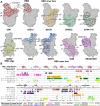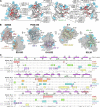Antibody-mediated immunity to SARS-CoV-2 spike
- PMID: 36038194
- PMCID: PMC9393763
- DOI: 10.1016/bs.ai.2022.07.001
Antibody-mediated immunity to SARS-CoV-2 spike
Abstract
Despite effective spike-based vaccines and monoclonal antibodies, the SARS-CoV-2 pandemic continues more than two and a half years post-onset. Relentless investigation has outlined a causative dynamic between host-derived antibodies and reciprocal viral subversion. Integration of this paradigm into the architecture of next generation antiviral strategies, predicated on a foundational understanding of the virology and immunology of SARS-CoV-2, will be critical for success. This review aims to serve as a primer on the immunity endowed by antibodies targeting SARS-CoV-2 spike protein through a structural perspective. We begin by introducing the structure and function of spike, polyclonal immunity to SARS-CoV-2 spike, and the emergence of major SARS-CoV-2 variants that evade immunity. The remainder of the article comprises an in-depth dissection of all major epitopes on SARS-CoV-2 spike in molecular detail, with emphasis on the origins, neutralizing potency, mechanisms of action, cross-reactivity, and variant resistance of representative monoclonal antibodies to each epitope.
Keywords: Coronavirus cross-reactivity; N-terminal domain antibody; Neutralizing variants of concern; Receptor-binding domain antibody; S2 antibody; SARS-CoV-2 neutralizing antibody; SARS-CoV-2 spike antibody; Spike epitopes.
Copyright © 2022 Elsevier Inc. All rights reserved.
Conflict of interest statement
Disclosures The authors declare no competing interests.
Figures






References
Publication types
MeSH terms
Substances
Supplementary concepts
Grants and funding
LinkOut - more resources
Full Text Sources
Medical
Miscellaneous

